Physical Address
304 North Cardinal St.
Dorchester Center, MA 02124
Physical Address
304 North Cardinal St.
Dorchester Center, MA 02124
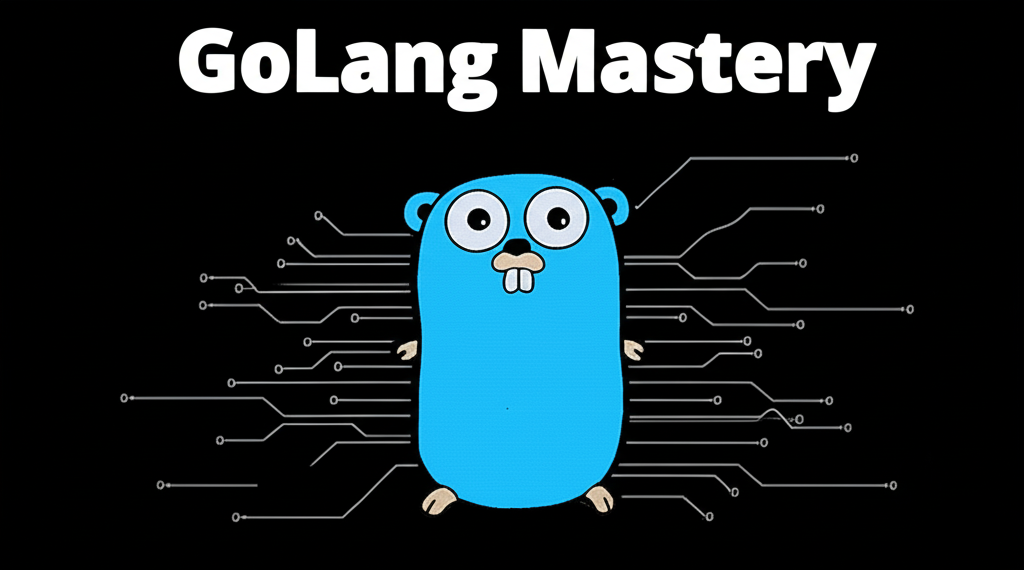
In today’s rapidly evolving software development landscape, few languages have captured the attention and strategic importance of Go (also known as Golang). The driving force behind the cloud native revolution and the backbone powering services at tech giants like Google, Netflix, Dropbox, and Uber.
The statistics speak volumes about Go’s meteoric rise. The global Go developer community has expanded to between 4.1 and 5.8 million professionals, with 1.8 million developers using it as their primary language. This explosive growth translates directly into career opportunities and financial rewards. Go developers consistently rank among the highest paid professionals in the industry, with average salaries around $76,000 and senior positions in the United States commanding up to $500,000.
What makes Go so compelling? It was born at Google specifically to tackle the challenges of building large-scale, networked software systems. The language’s clean syntax, lightning-fast compile times, and powerful built-in concurrency model make it perfectly suited for our cloud-first era. Essential tools that modern developers rely on daily, Docker and Kubernetes, are built with Go. The language has even surpassed Node.js as the preferred choice for automated API requests, showcasing its efficiency and reliability.
This comprehensive guide cuts through the noise. We’ve analyzed the learning landscape, reviewed curricula in detail, and synthesized feedback from thousands of developers to bring you the definitive breakdown of the seven best Golang courses available today.
Before diving into specific course reviews, let’s establish the criteria that distinguish truly effective Go learning resources. The best courses don’t just teach syntax—they instill the philosophy and engineering discipline that make Go so powerful in production environments.
Go’s built-in concurrency support is arguably its most significant feature and the primary reason it’s chosen for high-performance backend systems. A superficial explanation of the go keyword simply won’t cut it. Exceptional courses provide a deep, practical understanding of goroutines, channels, wait groups, and mutexes. They cover common concurrency patterns for orchestrating complex workflows and, crucially, the pitfalls like race conditions and deadlocks that can plague concurrent systems.
Mastering concurrency is what elevates a Go programmer from someone who can write simple scripts to someone capable of building scalable, resilient systems that handle thousands of simultaneous operations.
Go is famously “opinionated,” emphasizing simplicity, readability, and community-endorsed best practices. Top-tier courses teach you to write idiomatic Go code. This includes using tools like gofmt for standardized formatting, implementing robust error handling (a core Go principle), writing effective unit tests, and understanding proper interface usage for code decoupling.
Writing maintainable code that other Go developers can easily read and contribute to is essential for success in team environments and professional development.
There’s a world of difference between academic language overviews and instruction from professionals who’ve built, deployed, and maintained production Go applications. Seek instructors with real-world experience—professionals like Bill Kennedy of Ardan Labs, Stephen Grider, or Todd McLeod bring practical knowledge about performance tuning, architectural decisions, and subtle language nuances that only come from hands-on experience.
These experts teach not just the “what” but the crucial “why” behind Go’s design and best practices.
To help you navigate your options efficiently, here’s a quick comparison table followed by detailed reviews of each course:
| Course Name | Platform | Best For | Price Range | Standout Feature |
|---|---|---|---|---|
| The Official Go Resources | go.dev | Self-Motivated Learners & Experienced Devs | Free | Authoritative, interactive introduction from the source |
| Learn How To Code: Google’s Go | Udemy | Absolute Beginners Needing Comprehensive Foundation | $ | Massive content volume and university-style approach |
| Go: The Complete Developer’s Guide | Udemy | Efficient Learners & Visual Thinkers | $ | Crystal-clear explanations and superb concurrency deep dive |
| Programming with Google Go Specialization | Coursera | Academic Learners & Certificate-Seekers | $ | Structured, university-backed curriculum with verifiable certificate |
| Ultimate Go Training | Ardan Labs | Serious Professionals & Performance Engineers | $ | Unmatched depth on performance, internals, and advanced engineering |
| Learn Go | Codecademy | Hands-On Beginners & Quick Skill-Builders | Free | Best-in-class interactive “learn-by-doing” environment |
| Master Go (Golang): Complete Bootcamp | Udemy | All-Rounders Seeking Modern Bootcamp | $ | Comprehensive, up-to-date package with strong concurrency focus |
Overview: These official, free resources are created and maintained by the Go team at Google. “A Tour of Go” offers an interactive, browser-based tutorial covering core language features, while “Go by Example” provides a practical reference with annotated code snippets for common tasks.
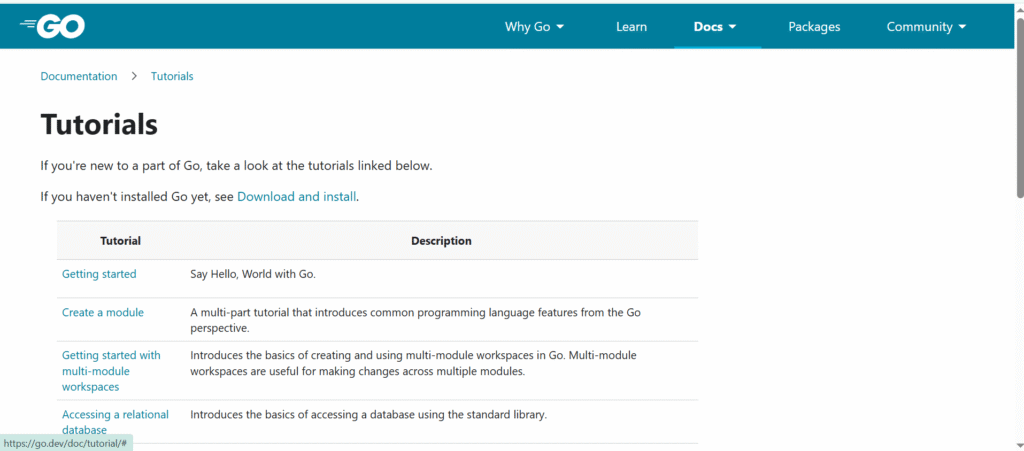
Curriculum: The tour covers Go fundamentals, including basic syntax, data structures, methods, interfaces, and an introduction to concurrency primitives. Go by Example provides practical code examples for everything from string formatting to file handling and goroutines.
Best For: Self-motivated learners and experienced developers seeking a quick start. Perfect for programmers transitioning from languages like Python or Java who want a fast, no-nonsense introduction to Go’s syntax and core idioms.
Pros:
Cons:
Stands Out For: Being the most direct, efficient, and idiomatic introduction to Go, straight from the language’s creators.
Overview: Taught by a university professor who was among the first to teach Go at the university level, this course is renowned for its comprehensive scope and detailed approach. Todd McLeod’s conversational teaching style includes contextual discussions that help students understand the broader IT landscape.
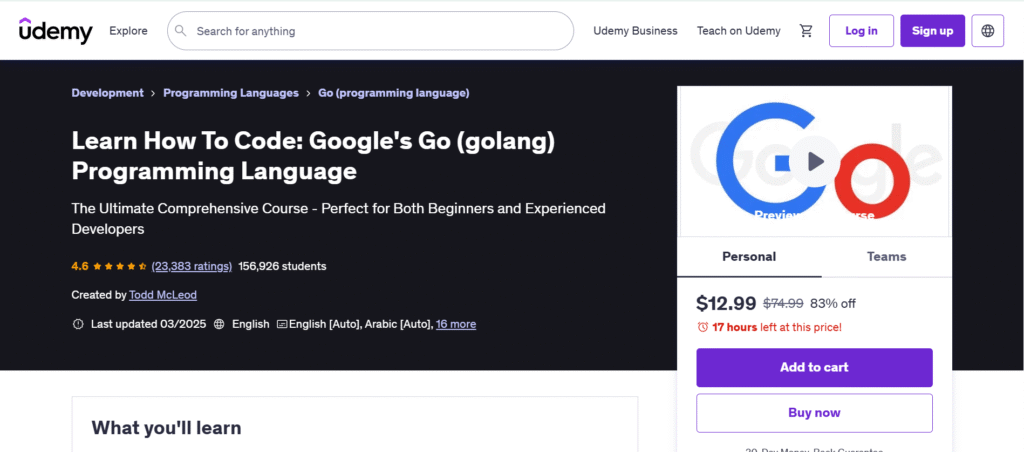
Curriculum: At over 29 hours, this is arguably the most exhaustive Golang tutorial available. It covers everything from absolute fundamentals to advanced topics including concurrency, channels, benchmarking, testing, robust error handling, and documentation. The course includes extensive hands-on exercises and a massive code repository.
Best For: Absolute beginners who want a deep, guided dive into Go. Perfect for individuals new to programming or those who thrive on detailed, step-by-step pedagogical approaches.
Pros:
Cons:
Stands Out For: Unparalleled content volume and proven university-level teaching methodology that has successfully guided thousands from beginner to competent Go programmer.
Overview: Stephen Grider brings his reputation for clear, concise teaching and excellent use of visual aids to this focused, efficient guide to Go’s most important features.
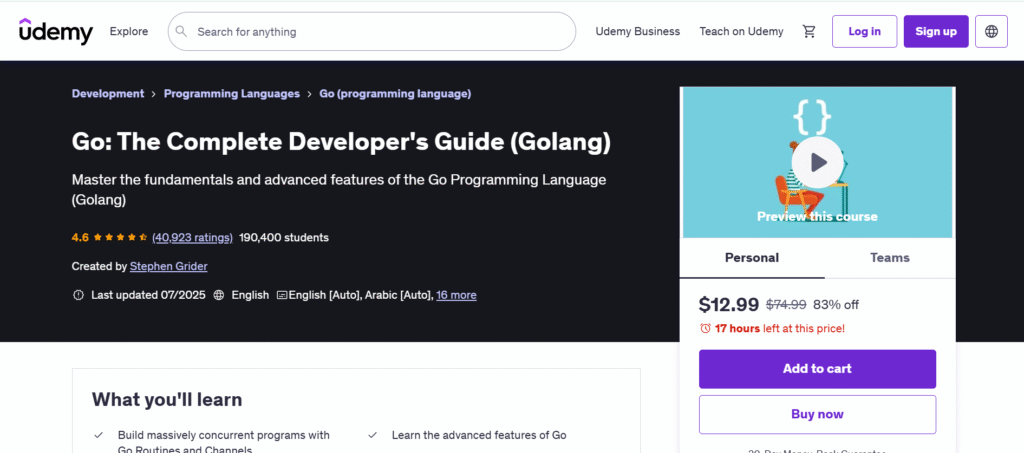
Curriculum: Built around two main projects—a card dealing program and a website status checker—the course covers Go fundamentals, data structures, interfaces, pointers, testing, and provides an exceptional deep dive into concurrency with goroutines and channels. A key feature is teaching students to effectively use official Go documentation.
Best For: Efficient learners and visual thinkers. Ideal for developers with programming experience who want to learn Go quickly and effectively, particularly those who appreciate visual explanations of complex concepts.
Pros:
Cons:
Stands Out For: Being the most efficient and visually clear introduction to Go’s most powerful features, especially its concurrency model.
Overview: The most academic and formally structured option, this University of California, Irvine specialization consists of three distinct courses providing a university-style curriculum.
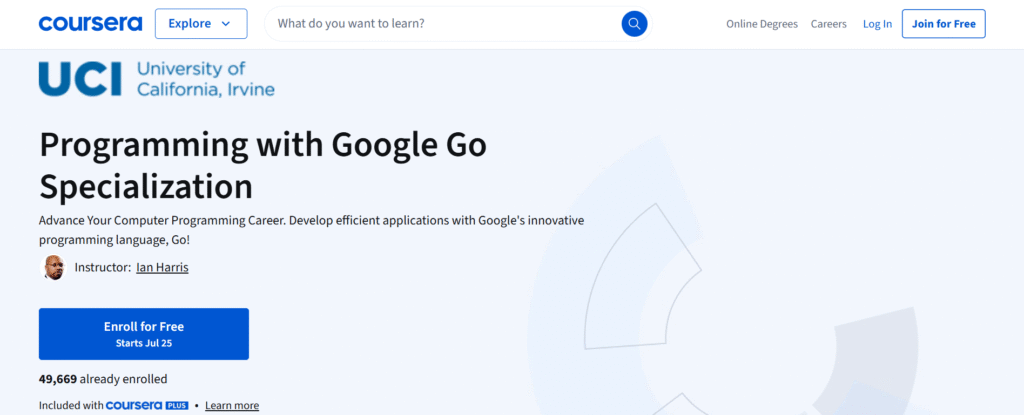
Curriculum: Logically divided into three parts:
Best For: Academic learners and certificate-seekers. Great for students, professionals preferring traditional academic structure, and anyone valuing formal, shareable credentials from recognized institutions.
Pros:
Cons:
Stands Out For: Offering a formal, university-backed learning path culminating in a highly credible and shareable certificate.
Overview: This premium, professional-grade training goes far beyond syntax. Taught by Bill Kennedy, a leading Go community expert, it’s an engineering deep dive into writing high-performance, idiomatic, and mechanically sympathetic Go code.
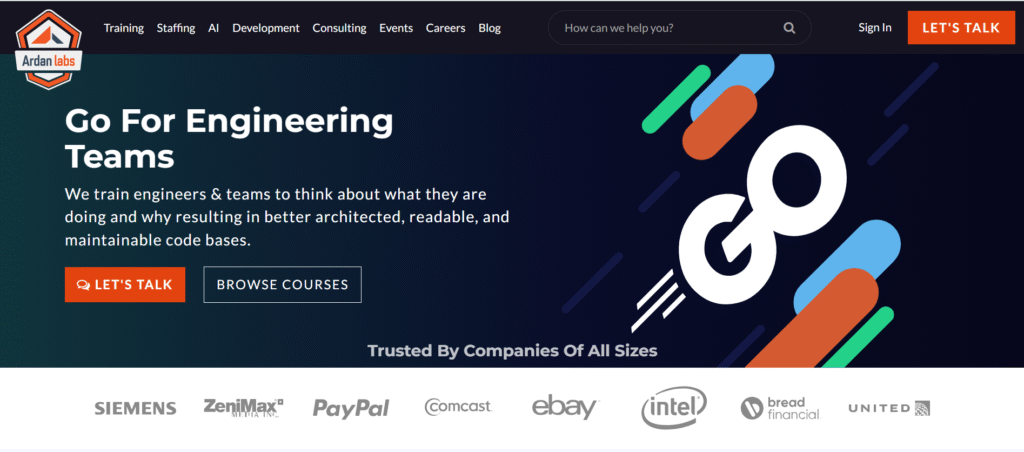
Curriculum: The Ardan Labs catalog includes several “Ultimate Go” courses. The core “Language Guide” focuses on data-oriented design, memory allocation, scheduler semantics, data races, profiling, and advanced concurrency. Advanced offerings like “Software Design with Kubernetes” teach production-level service building and deployment.
Best For: Serious professionals and performance-obsessed engineers. Designed for experienced developers who know Go basics and want true mastery, understanding the “why” behind Go’s design to write peak-performance production code.
Pros:
Cons:
Stands Out For: Being the undisputed resource for transforming competent Go developers into genuine experts, with laser focus on production-grade performance and internals.
Overview: Codecademy’s platform emphasizes “learning by doing” through a highly interactive experience with an in-browser editor providing instant feedback, making it an engaging way to master Go fundamentals.
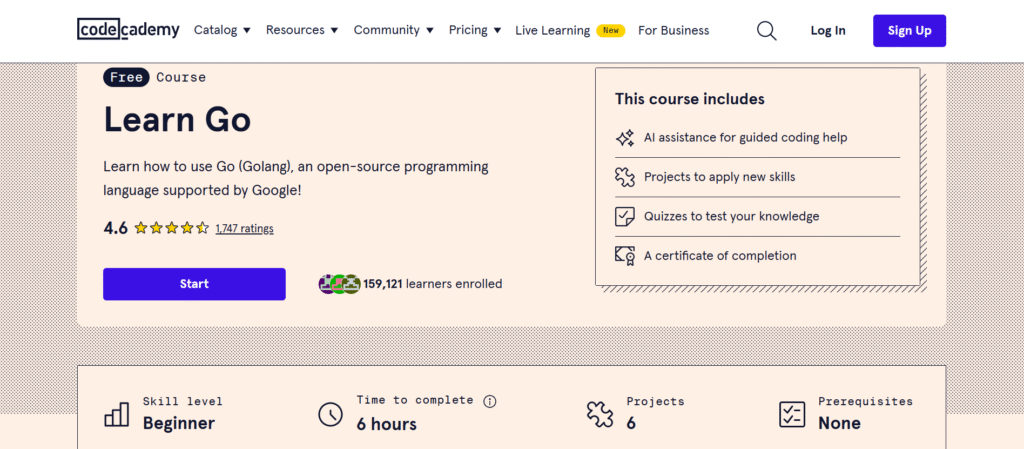
Curriculum: Structured path through Go’s core concepts including language introduction, variables, fmt package for I/O, conditionals, functions, and interfaces. Learning is reinforced through integrated quizzes and guided projects like fitness trackers and comic book inventory managers.
Best For: Hands-on beginners and quick skill-builders. Perfect for those who learn best by immediately writing code and want a gamified, interactive experience to quickly grasp Go syntax and concepts.
Pros:
Cons:
Stands Out For: Best-in-class interactive learning environment, making it one of the fastest and most engaging ways to get hands-on with Go syntax from day one.
Overview: A strong, modern boot camp effectively balances comprehensive coverage with practical, project-based learning. Taught by a senior software engineer, it serves as an excellent, up-to-date choice for learners seeking a complete package.

Curriculum: Covers the full spectrum of professional Go developer skills, starting with setup and tools, progressing through core concepts and data structures, and covering pointers, file I/O, methods, and interfaces. Includes deep concurrency coverage with WaitGroups, Mutexes, channels, and select statements, plus comprehensive package and module management.
Best For: All-rounders seeking a modern bootcamp experience. Fantastic for anyone from beginner to intermediate wanting a single, comprehensive, up-to-date course with strong emphasis on Go’s critical concurrency features.
Pros:
Cons:
Stands Out For: Being a fantastic, modern all-in-one package delivering a complete bootcamp experience with excellent, in-depth concurrency focus.
Absolutely! Go’s famously simple and clean syntax makes it more approachable for beginners than languages like C++ or Java. However, choosing a beginner-focused course is vital. Comprehensive, step-by-step courses like Todd McLeod’s on Udemy or Codecademy’s interactive path provide excellent starting points for newcomers to programming.
Timeline varies based on prior experience, time investment, and portfolio quality. However, the Go job market is exceptionally strong. High demand in booming sectors like cloud computing and backend services, combined with impressive salaries, indicates excellent prospects. Many students report landing positions after completing in-depth courses and building solid projects.
The official name is “Go.” The term “Golang” emerged as a convenient nickname, largely because the official website is golang.org. It’s commonly used as a search term and social media hashtag (#golang) to differentiate the programming language from the ancient board game. In professional conversation and writing, “Go” is the correct term.
Concurrency is Go’s solution to efficiently utilizing multi-core processors and handling thousands of simultaneous network requests. Instead of heavy operating system threads, Go uses extremely lightweight “goroutines”—you can run hundreds of thousands or even millions simultaneously. This makes Go exceptional for building fast, scalable applications like web servers, microservices, and data processing pipelines that need to handle multiple operations without performance bottlenecks.
Mastering Go represents a highly valuable and achievable goal for any dedicated developer. Its surging popularity, impressive salaries, and foundational role in modern technology architecture make it one of the wisest career investments you can make. The path from novice to expert is built on learning, practice, and continuous building.
Your journey begins with a single, well-chosen step. Use this guide not as a rigid ranking, but as a roadmap to find the course that best aligns with your career goals, learning style, and budget. Whether you start with a free interactive tour, an affordable bootcamp, or premium professional training, the most important thing is to begin.
As you progress toward Go mastery, remember that learning communities and resources like those found on mentorhelp.online provides ongoing support with guides, interview preparation, and career advice for every stage of your development journey. Your future as a proficient, high-impact Go developer awaits—take that first step today.